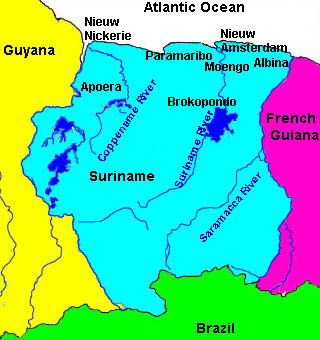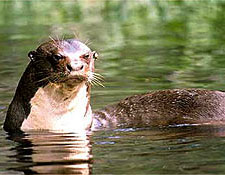|
Suriname, located on the northeastern Atlantic shore of South America, the only Dutch speaking country in South America, Suriname is the smallest country on the continent of South America. Neighbors to the west are Guyana, to the south Brazil and to the east is French Guiana. 
Adventure travelers are drawn to Suriname for its mixture of beaches, immense rain forest, Savannah and mountains. Suriname geography can be divided into 4 distinct regions. Along the Atlantic coast is the low coastal plain, a fertile and marshy region. Through the interior of Suriname lays vast areas of dense rain forest. To the south, flat grassy plains. And in the southern portion of Suriname are the highlands with the mountains increasing in height as they near the Brazilian border.
Paramaribo, the Capital of Suriname, lies in the low coastal plains region. The low coastal region is the most populated of the entire country with Paramaribo being the largest city with 250 thousand people of Suriname’s 470 thousand inhabitants.
Suriname is bisected by many rivers; the three main rivers crossing the country are the Suriname, the Saramacca and the Coppename Rivers. Suriname’s numerous rivers have also given the country many waterfalls. Located on the Coppename River are the Raleigh Fall waterfalls. In the northeastern section of Suriname is the world’s largest man made reservoir lake, located on the Suriname River, the Brokopondo Reservoir was created in 1964 by the building of the Afobakka Dam.
Suriname’s highest point is Julianatop at 4219 feet and is located in the center of the country and is part of the Wilhelmina Mountains. The two main mountain ranges in Suriname are the Van Asch Van Wijck Mountains and the Bakhuys Mountains.
 Suriname has one of the last untouched and unspoiled rain forests in South America, with areas still inaccessible to mankind; Surinames has one of the highest rainforest densities of any other South American country. The rain forest has a huge assortment of wildlife and is home to many rare species such as the harpy eagle and the giant river otter. The rain forest still have jaguar roaming the jungle with Howler monkeys filling the air with their screams. Large groups of blue and yellow Macaws can be found flying through the jungle. Suriname has one of the last untouched and unspoiled rain forests in South America, with areas still inaccessible to mankind; Surinames has one of the highest rainforest densities of any other South American country. The rain forest has a huge assortment of wildlife and is home to many rare species such as the harpy eagle and the giant river otter. The rain forest still have jaguar roaming the jungle with Howler monkeys filling the air with their screams. Large groups of blue and yellow Macaws can be found flying through the jungle.
Suriname’s climate is considered to be tropical, hot and humid; lying on the equator there is very little change in temperature year round. Suriname has mainly two rainy seasons running from November to January and again from May to August. Coastal areas are cooled by northeast trade winds.
Suriname was first explored by European explores during the 16th century, by the 17th century the Dutch and The English established plantations the many fertile river plains. Slavery, which was relied on heavily for the cultivation of the cotton, sugar and coffee plantations was abolished in 1863. Suriname became independent from the Netherlands in 1975.
Tourism has grown tremendously in the last decade, with travelers being drawn to the Suriname for its biodiversity of unspoiled rainforest. The Central Suriname Nature Reserve is one of the most popular and largest reserves in Suriname.
|